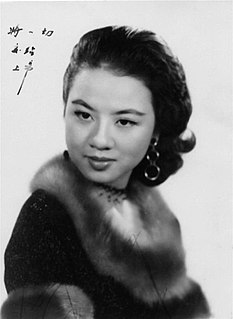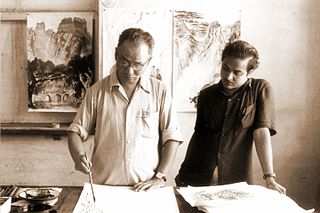 W
WChen Shuren was a Chinese painter. Born Chen Zhe (陳哲), he was renamed Chen Shao (陳韶) and also known by the art names De'an Laoren (得安老人), Jiawai Yuzi (葭外漁子), and Ershan Shanqiao (二山山樵), among others.
 W
WChen Wen Hsi was a Chinese-born Singaporean artist, known for his avant-garde Chinese paintings.
 W
WCheng Haw-Chien was born in 1948 in Penang, Malaysia. He studied the Lingnan style of painting, which fuses elements of Western and Japanese realism with Chinese ink painting on rice paper. He learned Chinese brush painting and western art forms enthusiastically when he was an adolescent. His interest was furthered when he continued his academic studies in Taiwan and Hong Kong after he graduated from secondary school. Thereon, he sought to refine his artistic skills under the guidance of many eminent masters. Former Principal of the Central Academy of Art and President of Central Research Academy of Art, Malaysia. He is currently a visiting professor of Renmin University of China, Ningbo University, Changshu University of Technology, and Handan College, and a life-long consultant of Ningbo Art Museum.
 W
WZhang Linlin, better known by the Hong Kong stage name Chung Ching, was a popular leading lady of Hong Kong films in the 1950s. After completing 54 films from 1953 to 1967, many of them in the leading role, she retired from film at the height of her career to become well known as a painter using both shui-mo and Western watercolor techniques.
 W
WFang Ganmin was a Chinese French-trained painter, sculptor and educator, who was educated in Paris and spent most of his adult life in China. Regarded as one of the fathers of Chinese oil painting, Fang was born in the Wenling county, Zhejiang province. He began studying painting in 1924 and went to Paris in 1925, enrolling in the École nationale supérieure des Beaux-Arts, making him, along with Xu Beihong and Sanyu, one of the first Chinese painters to study abroad in France. Upon returning to China, he taught at the National Arts Academy, Hangzhou, becoming a professor at the Western Painting Department. During the Cultural Revolution, Fang was shamed and tortured by the Red Guards, and his works were destroyed. He died in 1984. His students include Zao Wou-Ki, Chu Teh-Chun and Wu Guanzhong.
 W
WGao Xingjian is a Chinese émigré novelist, playwright, critic, painter, photographer, film director, and translator who in 2000 was awarded the Nobel Prize in Literature "for an oeuvre of universal validity, bitter insights and linguistic ingenuity." He is also a noted translator, screenwriter, stage director, and a celebrated painter. In 1998, Gao was granted French citizenship.
 W
WGuan Pinghu, was a leading player of the guqin (古琴), a Chinese 7-string bridgeless zither. Born in Suzhou, Jiangsu, Guan came from an artistic family, and started to learn the guqin from his father, Guan Nianci. After the death of his father when he was thirteen, Guan continued with his father’s friend Ye Shimeng and Zhang Xiangtao. He also studied with the leading players of three different schools; Yang Zongji (1865–1933), the leading player in Beijing, the Daoist Qin Heming, and the Buddhist monk Wucheng.
 W
WGuan Zilan, also known as Violet Kwan, was a Chinese avant-garde painter. She was one of the first artists to introduce Fauvism to China, and was known for applying Western painting style to Chinese traditional subjects. Her most famous work is Portrait of Miss L. (1929). Although an art world favorite during the late 1920s and the 1930s, she stopped painting after the onset of the Cultural Revolution and became mostly forgotten in Communist China.
 W
WHong Yi, born Li Shutong was a Chinese Buddhist monk, artist and art teacher. He also went by the names Wen Tao, Guang Hou, and Shu Tong, but was most commonly known by his Buddhist name, Hong Yi. He was a master painter, musician, dramatist, calligrapher, seal cutter, poet, and Buddhist monk.
 W
WLi Keran, art name Sanqi, was a contemporary Chinese guohua painter and art educator. Considered one of the most important Chinese artists in the latter half of the 20th century, he was also an influential professor at the Central Academy of Fine Arts where he taught a generation of Chinese artists. Although trained in Western oil painting, he was known for his traditional literati paintings with influences from Qi Baishi and Huang Binhong, two renowned masters in Chinese painting.
 W
WLiu Kang was a Singaporean artist known for his Balinese-themed figurative paintings. He was a founding member of the Singapore Art Society, and was credited with developing the Nanyang Style, an art style associated with the Nanyang Academy of Fine Arts. He is also the father of the architect Liu Thai Ker.
 W
WMoy Yat (梅逸) was a Hong Kong martial artist, painter, seal maker, teacher and author. He was a student of the legendary Wing Chun Kung-Fu teacher Yip Man from 1957 until Ip Man's death in 1972. Moy Yat is survived by his wife, Helen and his children Vieven, William and Viva. He also has Grandchildren and devoted students which are still alive.
 W
WMarguerite Müller-Yao (Chinese: 姚慧; pinyin: Yao Hui; was a Chinese-German painter and art historian. The aim and main subject of her artistic and scientific works were the cultural relations and influences between China and the West.
 W
WTan Ting-pho, was a well-known Taiwanese painter. In 1926, his oil painting Street of Chiayi was featured in the seventh Empire Art Exhibition in Japan, which was the first time a Taiwanese artist's work could be displayed at the exhibition. Tan devoted his life to education and creation, and was greatly concerned about the development of humanist culture in Taiwan. He was not only devoted to the improvement of his own painting, but also to the promotion of the aesthetic education of the Taiwanese people. He was killed as a result of the February 28 Incident, a 1947 uprising in Taiwan which was repressed by the Kuomintang (KMT).
 W
WLi Tiefu was a Chinese painter, sculptor, calligrapher and revolutionary, known for introducing western oil painting to China and for assisting Sun Yat-sen in funding the Xinhai revolution and overthrowing the Qing Dynasty. During his time in New York, he was a member of the National Academy of Design. Li Tiefu was hailed as one of the most important Cantonese artists of the 20th century at the Guangdong Art Centennial Exhibition.
 W
WTsang Tsou Choi, or the "King of Kowloon" (九龍皇帝) was a Hong Kong citizen known for his calligraphy graffiti.
 W
WWang Chiu-chiang, also known as 王九江, is a Sichuanese painter whose work is mostly based on the landscapes of Sichuan and Tibet, by reinterpreting the traditional shan-shui style. He is classified as a member of national first-class artists.
 W
WWang Xibang was a contemporary Chinese painter, calligrapher, poet, educator, and antique collector. Wang Xibang excelled in calligraphy and painting of plum blossom, pine, lotus, peony, wisteria, and loquat tree. He was the founder of Xin’an Association of Fine Arts, a member of the Chinese Artists Association, and a member of the Chinese Poet Association.
 W
WWen Wu is a portrait painter from Qingdao, China residing in London.
 W
WYan Wenliang was a Chinese painter and educator, who is regarded as one of the fathers of Chinese oil painting and an important art educator of his time. Born in Suzhou, Jiangsu province, Yan began studying painting in 1909, founded the Suzhou Art Academy along with Zhu Shijie in 1922 and went to Paris in 1929, enrolling in the L'Ecole Superieure Nationale des Beaux Arts, making him, along with Xu Beihong and Sanyu, one of the earliest Chinese artists to study abroad in France. He was one of the four pioneers of Chinese modern art who earned the title of "The Four Great Academy Presidents".
 W
WZao Wou-Ki was a Chinese-French painter. He was a member of the Académie des Beaux-Arts in Paris. Zao Wou-Ki graduated from the China Academy of Art in Hangzhou, where he studied under Fang Ganmin and Wu Dayu.
 W
WZhu Shijie was a Chinese painter and educator, who is regarded as one of the fathers of Chinese oil painting and an important art educator of his time. Born in Suzhou, Jiangsu province, Zhu began studying painting in 1912 and founded the Suzhou Art Academy in 1922. In the 1920s, Zhu went to Japan and brought back to China the Bauhaus concepts and ideas of practical art. Zhu, along with Yan Wenliang and Hu Cuizhong comprise the “Three Masters of Suzhou”.